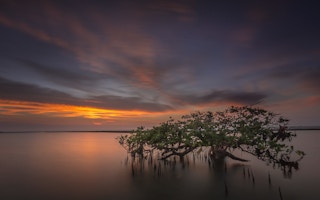Indonesia has revised down its 2021 target for rehabilitating mangroves in light of “technical hurdles” brought about by the Covid-19 pandemic and other factors, according to the nation’s mangrove restoration agency.
The new target is 33,000 hectares (81,500 acres), down from 83,000 hectares (205,000 acres), according to Hartono Prawiraatmadja, the head of the Peatland and Mangrove Restoration Agency. The larger plan to rehabilitate 630,000 hectares (1.55 million acres) by 2024 remains unchanged, he said.
In 2022, “the technical hurdles that we encountered in 2021 will no longer be there,” Hartono told journalists during a virtual press conference in October.
Indonesia is home to more than a quarter of the world’s mangroves — gnarled trees and shrubs that grow in sheltered, tropical coasts, where they buffer coastal communities against storm surges, tsunamis and sea-level rise, and bolster local livelihoods.
Mangroves also serve as carbon sinks, storing up to four times as much carbon as other tropical forests, research shows.
But the archipelago country has lost 40 per cent of its mangroves in three decades as people harvest the trees for timber and clear them to make way for fish and shrimp farms, the Centre on International Forestry Research (CIFOR) said in 2018.
Last year, President Joko Widodo’s administration announced the nation would rehabilitate mangroves spanning an area four times the size of London by 2024. The president sought to promote the programme through recent visits to rehabilitation sites in Bali and North Kalimantan, and he also cited it during his speech this month at the COP26 UN climate summit in Glasgow.
According to Hartono, the government was forced to revise the target while it developed a detailed technical plan.
“We don’t know yet the [precise] area [of the mangroves that can be rehabilitated] and where they’re located,” he said.
Some of the budget for the rehabilitation programme also had to be reallocated toward the pandemic response, Hartono added.
He said the government was on track to meet the 33,000-hectare target by the end of November.
With planning for 2022 already underway, Hartono said he was optimistic his agency would be able to speed up rehabilitation next year.
The targets are 228,200 hectares (563,800 acres) of mangroves to be rehabilitated in 2022, 199,675 hectares (493,400 acres) in 2023 and 142,625 hectares (352,400 acres) in 2024.
“Because we’ve already done the technical planning for 2022 in 2021, when the budget for 2022 is ready we can choose the right timing [to plant mangrove trees] in each location,” Hartono said. “Therefore, the technical hurdles that we encountered in 2021 will no longer be there.”
The programme is focused on mangroves affected by shrimp farming, the main driver of mangrove degradation in Indonesia.
Brackish water shrimp aquaculture, known locally as tambak, exploded in the 1980s and 1990s due to government policies encouraging aquaculture and to an increase in shrimp prices during the 1997 Asian financial crisis.
As a result, 800,000 hectares (1.97 million acres) of mangrove were cleared for aquaculture from 1970-2003. An additional 700,000 hectares (1.73 million acres) of mangroves may be lost in the next two decades if no actions are taken, according to a 2016 study.
The government says it hopes the rehabilitation programme can help meet its goal of turning Indonesia’s forests into a carbon sink by 2030 and bolster the nation’s “blue carbon economy,” according to deputy environment minister Alue Dohong.
Blue carbon is the carbon stored in coastal, tidal, wetland and marine ecosystems, including carbon-rich mangroves, salt marshes and seagrass meadows.
Preserving Indonesia’s mangroves could store up to 150 million tons of carbon dioxide equivalent per year, which could generate more than US$3 billion per year in abatement cost, according to CIFOR.
“The hope is for mangroves to be our biggest supporter in carbon trading,” Alue said at the press event.
Experts have pointed to a lack of reliable maps of the country’s mangroves — something Jakarta hopes to address with its new National Mangrove Map.
“We hope that after this launch [of the new map], the maintenance, rehabilitation, conservation and management of mangrove ecosystems can be sped up so that the target can be met,” chief investment minister Luhut Binsar Pandjaitan said at the launch of the map last month.
Previous efforts to rehabilitate mangroves often failed because local communities ended up clearing the trees to establish fish and shrimp farms, according to Nyoto Santoso, the head of the tropical forest rehabilitation research center at the Bogor Institute of Agriculture (IPB).
He recommended that planners incorporate silvofisheries, a practice where mangroves are planted alongside shrimp farms, into rehabilitation efforts.
“Do the locals accept [the rehabilitation program] or not?” Nyoto said in an interview. “If it’s a project, then the locals usually accept it because they’ll get money. But after the mangrove trees are planted, will they be disturbed [by locals]?”
Hartono, the mangrove agency chief, said all rehabilitation efforts would be done directly by local communities instead of being outsourced to third parties.
“Besides restoring the environment, we also provide job opportunities for locals who are impacted by the pandemic as well as increasing the welfare of the people who live in mangrove areas that have been degraded,” he said.
The government also plans to involve local communities in the management of mangroves post-rehabilitation so that the trees can be protected well into the future, Hartono said.
“If peatlands and mangroves that have been rehabilitated aren’t managed well, they’ll soon be degraded again,” he said.
This story was published with permission from Mongabay.com.










